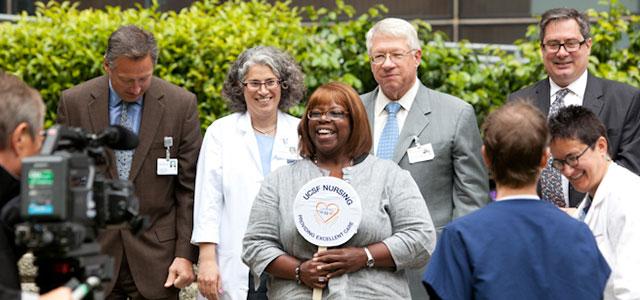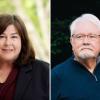
UCSF Medical Center team prepares for a video shoot designed to inspire and prepare nursing staff for a five-day site visit by Magnet appraisers (photos by Elisabeth Fall).
Portrait of a Magnet
In the fall of 2012, UCSF Medical Center and UCSF Benioff Children’s Hospital achieved Magnet® recognition from the American Nurses Credentialing Center (ANCC). The recognition has elicited enormous pride throughout the organization, from the chief nursing officer (CNO), chief executive officer (CEO) and chief medical officer (CMO) to the frontline nursing staff, UCSF School of Nursing and beyond.
And why not? Magnet recognition signifies outstanding nursing practice, a rewarding work environment for nurses and improvements in patient care, safety and satisfaction. As of this writing, less than 7 percent of the 5,724 hospitals registered with the American Hospital Association had achieved Magnet status.
“At two in the morning in the hospital, you want to know you have nursing staff that feels completely capable of making the best possible clinical decisions,” says Karen Drenkard, executive director of the ANCC and a former chief nursing officer at a Magnet hospital. “Magnet recognition helps give you that assurance, because it is a very high, evidence-based bar.”
But for those outside of the process, what constitutes that evidence-based bar can be a little mysterious. Most know little about the standards that Magnet organizations meet and less about how meeting them translates into improvements in patient care.
That was true even for some at UCSF when what everyone involved refers to as “the Magnet journey” began.
The Beginnings
 Mark Laret “I think the first Magnet discussion I had with nursing leadership dates back to 2000,” says UCSF Medical Center CEO Mark Laret. “There were some number of hospitals that had achieved Magnet, but at the time, it just wasn’t an institutional priority here.”
Mark Laret “I think the first Magnet discussion I had with nursing leadership dates back to 2000,” says UCSF Medical Center CEO Mark Laret. “There were some number of hospitals that had achieved Magnet, but at the time, it just wasn’t an institutional priority here.”
By 2005, a UCSF team did put together a Magnet application, but much to a proud institution’s shock, the application was denied.
“That was a watershed moment, because there’s always this fine line between being confident and overconfident,” says Laret. “I worried maybe we were overconfident in where we were relative to having accomplished the goals Magnet sets out, so when we hired Sheila [Antrum] to become CNO [in 2007], we talked about what it would take to achieve Magnet status.”
By then, the Magnet process had evolved. “Before it was more around anecdotal stories and aggregate data to meet the criteria, but…now you have to demonstrate – by unit and top to bottom – that you’re meeting nursing-sensitive benchmarks of quality and satisfaction,” says Antrum.
“We enhanced the structures and processes that we had in place to demonstrate our outcomes,” says Director of Professional Nursing Practice and Magnet Program Director Jody Mechanic.
That process began in earnest in 2010, and Antrum believes the collecting of baseline data in and of itself helped demonstrate one value of Magnet: heightened awareness of the need for evidence throughout the hospital and especially among an already outstanding group of nurses who may not have understood just how outstanding they were.
“At UCSF, we don’t rest on our laurels and can even be a little self-flagellating,” says UCSF Medical Center Chief Nurse Researcher Daphne Stannard (UCSF School of Nursing, PhD 1997). “Experts tend to not think of themselves as experts – how can I be an expert if I’m always learning? Our nursing staff epitomizes that, and some didn’t feel we were Magnet worthy.”
Over the next two years – working with Stannard, medical center staff, and faculty from UCSF School of Nursing – Antrum and Mechanic led a team that gathered the baseline data, identified gaps and planned and implemented improvements. They compiled a 3,000-page application that painstakingly documents how the two hospitals, ambulatory care services and home care were meeting Magnet benchmarks – and then the entire enterprise underwent a five-day site visit by Magnet appraisers.
It was a demanding, at times exhausting journey that helped the entire medical center better understand nursing’s contribution to outstanding patient care and set in place the expectation of continual nursing improvement rooted in Magnet’s five model components – transformational leadership; structural empowerment; exemplary professional practice; new knowledge, innovation and improvements; and empirical quality results.
Transformational Leadership
“Today’s leaders must transform their organization’s values, beliefs, and behaviors.… The transformational leader must lead people where they need to be to meet the demands of the future.” – From the Magnet Recognition Program® Model
A few years back, at a monthly dinner for the chief residents and medical center leadership, one of the residents casually mentioned that he knew little about what nurses actually did. Laret was struck by the comment, which shortly thereafter led to the formation of a nurse-resident council.
“I hoped it marked the end of an era where the doctor was king and nurses followed orders,” says Laret. “Our residents and nurses have developed a profound respect for each other, much greater than I’ve ever seen in my career.… We’ve moved to the point where they really see the value of the team and don’t have this hierarchical view of who does what.”
This is a recurring theme when people comment on the leadership style at UCSF. It’s not just that nurses are embedded in interprofessional leadership teams throughout the hospital, but also that nursing leaders work with their own staffs in nonhierarchical ways to effect improvements. It’s an ideal that Antrum has strongly encouraged.
“As we moved to this self-empowering, team-based approach, I spent a lot of time with managers, exploring their role,” says Antrum. One of the nurse managers had come from a Magnet hospital, and she became a coach and facilitator who showed other managers how to problem-solve with staff.
Antrum believes this approach works especially well when senior leadership is adept at identifying people’s strengths and leveraging them. “Because I’m not a great public speaker, when our councils come together, I’ve found others who are articulate about speaking up for nursing practice,” she says. “This helps physicians appreciate what we do and elevates nursing to where it needs to be.”
“Think of someone like me,” says Lee Greenholtz, an administrative nurse in the intensive cardiac care unit. “Lifelong nurse at UCSF, some skill at management…but I have a staff nurse who was president of the board of directors at a private school and knows many things that I don’t.… It’s about accessing all the talent around you.”
This leveraging of people’s strengths has led to a remarkable array of interdisciplinary, nurse-led initiatives to improve patient care that, Stannard says, reflect the culture she found when she arrived at UCSF over 20 years ago.
As an example, she describes a situation recently where the medical center was considering a policy change intended to enhance patient safety, but which unwittingly changed a nursing practice that was helping patients cope with pain. Nurses spoke up and began collecting data on the unit most affected, leading to reconsideration of the policy. “There are very few clinicians here so full of dogma that they can’t be open to other caregivers,” says Stannard.
“I go up on the units and see on the bulletin boards the profiles of the work undertaken in a thoughtful, interdisciplinary way – the entire care delivery team taking on patient safety, medical management – and so often nursing is leading the process redesign, driving important change on behalf of patients,” says Laret. “They’re leaders, who happen to be nurses, leading huge improvements in care.”
Structural Empowerment
“Solid structures and processes…provide an innovative environment where strong professional practice flourishes and where the mission, vision and values come to life.” – From the Magnet Recognition Program Model
“When you’re putting in structures, the early adopters buy in. After a few years, a lot of others realize the structures give them avenues to do their jobs better, and it re-energizes them and makes it easy for them to put in their contributions,” says Greenholtz.
“It is essential for nurses to be involved in decisionmaking that involves patient care and professional practice,” says Mechanic. The shared decisionmaking structure at UCSF includes:
- An overarching shared decisionmaking council, called the coordinating council
- Departmentwide clinical practice, quality, professional development/workforce, patient relations, and research and innovation councils
- Population-specific peer councils, including the nurse-resident, staff advisory, patient care manager, ambulatory and home care councils
- A full complement of departmental and unit-based councils
These councils appear to be more than formalities. The nurse-resident council, for example, focuses on improving patient outcomes by improving communication and collaboration. “Nurses and residents have focused on the importance of building relationships, and several units have created unit-based nurse-resident councils. There are also photo boards of nurses and residents to identify people by name,” says Mechanic.
The nursing clinical quality council collaborated with the Department of Patient Safety and Quality to launch the Quality Celebration Event, a day for showcasing quality improvement projects implemented throughout the organization. Two annual events to date have yielded over 40 projects each year for poster presentations, many of which have been interdisciplinary.
“It gives people throughout the organization an opportunity to share best practices,” says Mechanic.
The unit-based councils might work on items such as communication handoffs to each other and unit-specific initiatives to improve care for patients and their families. This helps alleviate some of the anxiety around admission and care plans. The councils also keep a close eye on nursing-sensitive measures, such as pressure ulcers and falls.
Christy Carley, a charge nurse in the urology faculty practice, facilitates the ambulatory care council. She notes that the ambulatory world is different from the hospital, and in the past, individual practices would have little understanding of what their neighbor was doing.
“Once [the ambulatory care] council got involved, we started realizing the implications of what we could accomplish in attaining Magnet,” says Carley.
The group has created an ambulatory nurse resource guide and put it on the intranet to help ensure better patient follow-up and continuity of care. It has also created ambulatory nurse grand rounds to formalize the sharing of best practices.
That’s not to say maintaining all these councils and realizing the ideal of shared governance is easy. Keeping shared governance vital requires vigilance, says Greenholtz, but when it’s working, it’s powerful. “If something comes up, like skin breakdown, we all think about how are we going to resolve it and come up with a much more workable solution.”
Exemplary Professional Practice
“Exemplary professional practice within nursing…entails a comprehensive understanding of the role of nursing; the application of that role with patients, families, communities, and the interdisciplinary team; and the application of new knowledge and evidence.” – From the Magnet Recognition Program Model
“We’ve had observers comment on a level of performance and intuitiveness and articulation that is different from other places,” says Antrum.
“There are so many areas to highlight,” says Brigid Ide (UCSF School of Nursing, MS 1979), executive director of Patient Safety and Quality. “Some of the more important contributions include improving surgical care – making sure patients receive timely antibiotics before surgery and are discontinued appropriately according to scientific evidence, and assuring that each surgery or procedure has a final time-out to check for the essential safety components. Nurses also took control of managing the patients’ blood glucose levels after surgery. This intervention has been demonstrated to have better outcomes for the patient postrecovery.”
Antrum points to how nurses within the hospital were the primary trainers on how to use the new electronic health records (EHR) system, which made deployment much easier for everything from bar coding to clinical documentation. The Magnet team arrived only six weeks after the EHR implementation, and they were amazed at how smoothly it had already been incorporated.
Yet the nurses also refuse to be slaves to the technology. “I’m amazed at how our nurses own medication management,” says Antrum. “Just because it’s been ordered in the system, it’s not enough for them; they diligently oversee what patients take and where things break down, and write incident reports that analyze why errors occur. They’re smart enough to think, ‘We’re not going to depend on the system.’”
Physician Michael Gropper, director of critical care medicine, points to the performance and role of nurses in the ICUs he oversees. “We’ve gotten a lot of recognition – awards, kudos – for the quality of our ICU care, and most savvy physicians know good outcomes depend on good nursing care,” he says.
He describes how on daily rounds, the first person he speaks with is each patient’s bedside nurse. “We have embraced multidisciplinary rounds, where nurses are empowered to speak out; that’s what makes a safe environment, to speak out when something is not quite right.”
He notes that another major change at UCSF has been the incorporation of nurse practitioners (NPs) – approximately 15 in the ICU. “It’s a new role,” he says. “The NPs function as high-level resident physicians doing comprehensive care that includes physical exams, determining a treatment plan in collaboration with the intensivist, doing procedures like central venous access, and undertaking full order-writing capabilities.”
The Magnet process, many believe, has only enhanced this facilitywide commitment to exemplary practice.
New Knowledge, Innovation and Improvements
“Magnet organizations have an ethical and professional responsibility to contribute to patient care, the organization, and the profession in terms of new knowledge, innovations, and improvements.… This Component includes new models of care, application of existing evidence, new evidence, and visible contributions to the science of nursing.” – From the Magnet Recognition Program Model
“My greatest joy is to work with direct care nurses, who may not have a lot of research background, but who have good clinical questions worth pursuing, grounded at the level of the patient and family,” says Stannard. “That’s where a lot of good translational work happens.”
In the Magnet document, Stannard highlighted a collaborative effort among Neuro ICU nurse Amy Dunne, Neuro ICU Patient Care Manager Alberto Garcia and UCSF School of Nursing faculty members Mary Louise Fleming and Shirley Kedrowski. The project sought to reduce the use of restraints for patients in the Neuro ICU, which are often used to avoid having patients pull out things like their ventilator tubes or catheters.
Dunne had come up with the idea, and she worked with Stannard to design and implement a qualitative study to understand how ICU nurses assessed risk and justified the use of restraints. The team now has a finished manuscript that they hope to publish soon.
“What was really gratifying was how engaged Amy was throughout the research process,” says Stannard. “Now she wants to test some tailored interventions.… These kinds of things are happening throughout the medical center.”
Another way new information works its way into the medical center is through its close relationship with one of the world’s leading schools of nursing. Sometimes this involves collaborative research, such as the project in the Neuro ICU, or when UCSF School of Nursing faculty member Barbara Drew worked with nurses in two cardiac units to develop protocols for ST segment monitoring, which can lead to early identification of heart attack. The work led to Drew publishing the American Heart Association’s recommendations for this type of monitoring.
Rebecca Comfort, a staff nurse on the cardiovascular-thoracic unit, recalls being required to complete the online modules for learning how to do the ST segment monitoring, along with everyone else on her unit. “My unit is one of the largest, 45 beds, around 80 nurses,” she says. “But every bedside nurse can explain the difference between pre and post data in this type of monitoring.”
Beyond research, expert faculty from the School will regularly make rounds. Nancy Stotts for wound healing and Kathleen Puntillo for palliative care are two examples.
“I’m grateful for our relationship to the School and any help we can get in doing our daily work and also promoting research and implementing new practices,” says Greenholtz. “And we can help the school too – our observations and experience are very valuable to leaders in the field.”
Former Associate Dean for Administration Zina Mirsky – who was on the Magnet Steering Committee – agrees. “Medical center staff does a wonderful job of teaching our students and collaborating with our faculty – and our faculty provides expert consultation to the medical center staff,” she says.
She believes that the opportunities for this type of collaboration will only increase. The current emphasis on service learning is a wonderful example, where School of Nursing students could be available to address a project that medical center staff has identified as important. “That’s the type of thinking that can emerge from a Magnet application – a more systematic approach to getting value from both sides,” she says.
In fact, says Stannard, money has been set aside to foster greater collaboration, and she is discussing a number of ongoing and potential future projects with the School.
“If we want to maintain Magnet status, we have to have a robust, nursing-driven research program. Thankfully, our hospital has always supported this type of research,” says Stannard.
Empirical Quality Results
“The question for the future is not ‘What do you do?’ or ‘How do you do it?’ but rather, ‘What difference have you made?’ … Outcomes need to be categorized in terms of clinical outcomes related to nursing.” – From the Magnet Recognition Program Model
Magnet recognition requires facilities to document specific nursing-sensitive outcomes and indicators in a number of key areas, including falls, pressure ulcers, central line-associated bloodstream infection (CLABSI), ventilator-associated pneumonia (VAP), restraints and urinary tract infection (UTI). In each category, the minimum requirement to achieve Magnet recognition is that more than 50 percent of the units measured must exceed the national mean or median for each key area.
The chart below, submitted to the Magnet Recognition Program, summarizes two years of data from the UCSF Medical Center and UCSF Benioff Children’s Hospital. For all quality indicators, UCSF Medical Center and UCSF Benioff Children’s Hospital outperformed the benchmarks more than 50 percent of the time over the two-year period.
Nursing Sensitive Indicator (NSI)
Units
National Benchmark
Summary of Outcomes
Falls
Adults,
Emergency (ED)
and Labor and
Delivery (15 Long)
NDNQI Mean
19 of 26 units
73% of units outperforming benchmark
Pediatrics
CALNOC
National Mean
Pressure Ulcers
Adults and
Pediatrics
NDNQI Mean
18 of 24 units
75% of units outperforming benchmark
CLABSI
Adult Critical
Care and Pediatric
Critical Care
NHSN Pooled Mean
7 of 7 units
100% of units outperforming benchmark
VAP
Adult Critical
Care and Pediatric
Critical Care
NHSN Pooled Mean
6 of 6 units
100% of units outperforming benchmark
Restraints
Adults Med/Surg
and Pediatric
Med/Surg
NDNQI Mean
18 of 20 units
90% of units outperforming benchmark
UTI
Adults Med/Surg
and Pediatric
Med/Surg
UHC Median
16 of 16 units
100% of units outperforming benchmark
“Those are good numbers, but our goal is always to be the best,” says Maureen Buick, director of nursing education and performance improvement. “We are continuing to measure, using even more stringent benchmarks, and looking for improvement every quarter.”
The Future
Perhaps one of the most powerful things about the Magnet program, says Mechanic, is the importance of sustaining and continually improving the outstanding work. The recognition lasts only four years, and Magnet facilities must provide interim reports.
“The biggest challenge with sustainability is succession,” says Greenholtz. “At first, you get 15 people willing to take on council work – but three to four years later, if you haven’t figured out how to rotate people through, then you end up frozen.” Consequently, she says, one effort in place is to get every clinical nurse leader to identify a person they will mentor to take over the leader’s position.
Of course, the Magnet Recognition Program holds itself accountable as well. “The standards are currently under review as part of our three- to five-year review process, though nothing changes unless the evidence suggests it needs to,” says Drenkard. “We are going to be releasing a new manual at end of first quarter [to take effect in 2014] to eliminate some redundancies, and we’ll probably consolidate some of the standards, but the emphasis on clinical outcomes will continue – and in the future, we’ll probably be looking more at coordination of care outside of the hospital walls.”
But even as both the Magnet program and the UCSF Medical Center evolve, the successful Magnet journey has left its mark.
“Because we have a self-effacing culture, I was nervous that our nurses would not be able to go out there and expound upon what they do for patients and patient care every day,” says Antrum. “The process helped them understand that what we do is not necessarily what’s done in other places, and they’ve learned how to speak to that very eloquently.”
“By becoming recognized as a Magnet facility, nurses realize the value of what they do on a daily basis,” says Stannard. “And that goes a long way toward underscoring our role as a center of nursing excellence.… I feel it when I walk through the halls. There’s an electric energy throughout the medical center.”
“For me, the lasting impact is that it shows UCSF values nurses and lets me know they want to retain nursing talent and improve patient care through our projects,” says Carley. “Magnet gives us a voice and opens the door to showing nurses how much we can accomplish.”



